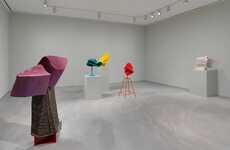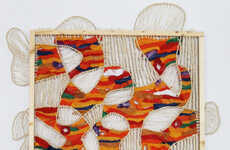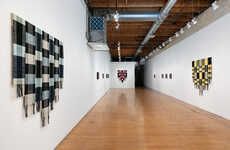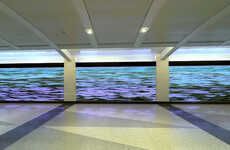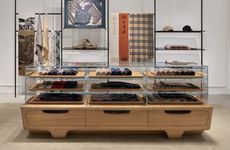
"Polytychs" by Artist Suzy Andron
Kim — January 7, 2008 — Art & Design
References: andron & salon-moxie
Continuing its revolving art displays, Salon Moxie, a hair salon in Raleigh, North Carolina, is hosting two new large works by Raleigh artist Suzy Andron.
Andron connects multiple canvases of highly textured abstract acrylic compositions to create what she calls polytychs. She defines her work as “adjacent groups of two or more stand-alone but related canvas paintings†which allows her to play with the paintings' perimeters to produce new geometric forms.
“In 2000, I started painting triptychs,†she explained. “Soon I expanded to more than three combined pieces, and they became polytychs. The canvases wanted to rotate, so I applied geometry to the mix. My polytychs continued to evolve, now into new dimensions. I turned a few canvases backward while still connecting them with the others. I experimented with triangular canvases. I introduced different textures, and worked with how they interact. Right now, I'm developing pieces that are composed of several layers of canvases and new base materials.â€
A painter for “as long as I can remember,†she said, Andron earned a bachelor's degree in Fine Art and Art Education at The Pratt Institute in New York in 1968 and a masters degree in landscape architecture at North Carolina State University in 1980. She has taught interior design at UNC-Greensboro and currently teaches color and design fundamentals at the Meredith College Art Department. Her work has been shown at the Park-Art Gallery in New York City, among other venues. In 2004 she was included in the juried exhibit “Best Artists in the Triangle†at the Lee Hansley Gallery in Raleigh.
The two large polytychs – “Living Water†and “M†-- will remain in Salon Moxie through February. For more information on Suzy Andron and her work, visit http://www.andron.com.
Salon Moxie is located at 6191-122 Falls of Neuse Road, Raleigh. For more information, including business hours, visit http://www.salon-moxie.com or call 919-850-0721.
###
Andron connects multiple canvases of highly textured abstract acrylic compositions to create what she calls polytychs. She defines her work as “adjacent groups of two or more stand-alone but related canvas paintings†which allows her to play with the paintings' perimeters to produce new geometric forms.
“In 2000, I started painting triptychs,†she explained. “Soon I expanded to more than three combined pieces, and they became polytychs. The canvases wanted to rotate, so I applied geometry to the mix. My polytychs continued to evolve, now into new dimensions. I turned a few canvases backward while still connecting them with the others. I experimented with triangular canvases. I introduced different textures, and worked with how they interact. Right now, I'm developing pieces that are composed of several layers of canvases and new base materials.â€
A painter for “as long as I can remember,†she said, Andron earned a bachelor's degree in Fine Art and Art Education at The Pratt Institute in New York in 1968 and a masters degree in landscape architecture at North Carolina State University in 1980. She has taught interior design at UNC-Greensboro and currently teaches color and design fundamentals at the Meredith College Art Department. Her work has been shown at the Park-Art Gallery in New York City, among other venues. In 2004 she was included in the juried exhibit “Best Artists in the Triangle†at the Lee Hansley Gallery in Raleigh.
The two large polytychs – “Living Water†and “M†-- will remain in Salon Moxie through February. For more information on Suzy Andron and her work, visit http://www.andron.com.
Salon Moxie is located at 6191-122 Falls of Neuse Road, Raleigh. For more information, including business hours, visit http://www.salon-moxie.com or call 919-850-0721.
###
Trend Themes
1. Multi-canvas Art - Exploring the use of multiple canvases connected together to create unique compositions, opening up opportunities to experiment with new geometric forms.
2. Textured Abstract Acrylic Compositions - Using highly textured techniques in abstract acrylic compositions to add depth and texture to artworks, offering new possibilities for expression.
3. Collaboration Between Art and Design - Blending art and design by incorporating different base materials and layering techniques, presenting innovative ways to merge artistic disciplines.
Industry Implications
1. Art Galleries - Art galleries can explore opportunities to showcase artists working with multi-canvas art and textured abstract acrylic compositions, providing unique experiences for art enthusiasts.
2. Interior Design - Interior design professionals can incorporate multi-canvas art and textured abstract acrylic compositions into their projects, adding visually engaging elements to spaces.
3. Art Education - Art educators can incorporate the exploration of multi-canvas art and textured abstract acrylic compositions in their curricula, fostering creativity and pushing boundaries in students' artistic development.
0.8
Score
Popularity
Activity
Freshness




